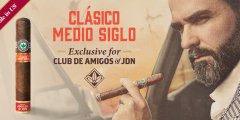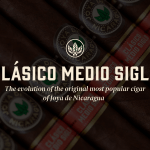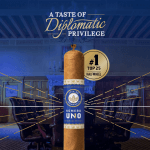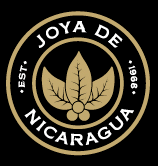We Will Make Sure to Put Only the Best Tobacco in Our Cigars – [Interview]
Joya’s Owner and Chairman was interviewed by one of the most important Nicaraguan newspapers about the 5th Nicaraguan Cigar Festival, and the current state of the Tobacco Industry in Nicaragua.
The Nicaraguan Tobacco Industry is experiencing one of its best moments. It occupies a place of importance in the national economy and puts Nicaragua in a privileged international position.
Dr. Alejandro Martínez Cuenca, Chairman, and Owner of Joya de Nicaragua says that the country “has been growing its production and export of cigars in a consistent way and, according to data from the Association, in 2014 we had already generated US $168 million in export.”
Could you give me a quick rundown of the sector?
In 1977, after Cuba, Nicaragua was the first producer of cigars in the world. We exported 13 million cigars at that time. The Dominican Republic in the same year exported 5 million cigars.
Then in the 90s, Nicaragua exported just 1.2 million of cigars and The Dominican Republic cigars 52 million. That was the tipping point when they began to surpass Nicaraguan exports.
In the 70s, after Cuba, Nicaragua was the largest producer of cigars in the world. That changed after 2006 when Tobacco companies began to invest in the production of tobacco and with more confidence.
At that time, the change of government occurs and most Cubans producers settled in Miami were afraid of what was coming, but they managed to create a climate of trust to the point that from 2006 to date, exports have grown quickly.
What is the highest price for a Premium cigar?
It is insane. There are Nicaraguan cigars that can be sold for $40 or $50 per unit on the market in Europe and the United States. But there are cigars sold on average for $8 per unit. This is an industry that has required a lot of effort from Tobacco Producers. The government is also supporting the development of this industry.
I understand that at the Cigar Festival there will be a panel on the history and future of the Cigar Industry in Nicaragua. Will you take part in the symposium, if so can you give us a preview of what you will present?
First highlight the significance of manufacturing cigars in the context of Nicaragua, and most importantly, that we can say that tobacco was one of the cornerstones for combating poverty. However, this effort has never been noted.
In the 20s and 30s, in other words, early last century, there were plans for the Coffee and Cattle industry to help the economic sectors grow. However, there was never a program with the primary objective of combating poverty.
That is until 1933 with a program initiated Augusto C. Sandino when he required President Juan Bautista Sacasa to remove the restriction that the Americans forced him to impose on Nicaragua during the government of President Moncada, where the state regulated the cultivation of tobacco.
In that famous letter, Sandino writes to Sacasa that they need to eliminate poverty in the mountains of Nueva Segovia and only a project like the cultivation of tobacco could provide farmers with an income to lift them out of poverty. Unfortunately, this has never been discussed, even though it is part of history. I want to use the Nicaraguan Cigar Festival to recover this story.
Are we still on the same page? Is the United States putting restrictions on the Nicaraguan Cigar?
Today there are forces in the United States and Europe wanting to limit people their access and ability to purchase cigars. It has been a tough battle, there are restrictions by the US Congress, especially with taxes, restricting the importation of cigars to Nicaragua. Paradoxically, we always had the same problem. In the 30s, before tobacco became what it is today in Nicaragua, we could not grow tobacco per a restriction where President Moncada had given the Americans so that tobacco producers in The United States did not have any competition.
How do you see the Cigar Festival this year? Is there more interest in participating?
Compared to past years there has been an increase in participants and an inability to accommodate more people because there are no places in Esteli that can cope with the demand. There are certainly more hotels, but not enough, especially hotels that can provide a particular quality of service. This influx of visitors is not unexpected, it is the product that Nicaragua today, more than ever, is present in the consumer world. We have a product that is known and ranked globally as one of the highest quality.
You are recognized nationally and internationally as one of the key figures of Nicaraguan cigars. However, we have noticed that you’ve had little public appearances lately. How so? We ask this question because in our culture it is rare for people as successful as yourself to want to be in the background. How do you explain this?
Throughout life, there are always new ideas and concepts to be applied and my understanding is that at this time we have built a group of solid work teams. Joya de Nicaragua, for example, a company led by young people, where the president is Juan Ignacio Martinez, who is also president of the Chamber of Tobacco, I have recognized that my most valuable contributions are not necessarily done at the forefront of the operation.
I can, with the experience accumulated over the years, help these new generations. I think the generational replacement is required, especially in an industry that is so dynamic and therefore, shifting to the background could be interpreted as actually supporting the advancement of the industry and future generations. We must leave this new generation to act freely while listening to the advice of those of us with the voice of experience.
I understand that this office, where we are doing this interview, is a Joya de Nicaragua official store, but there is also a barber shop, recently opened. Can you explain the concept you are trying to develop?
We want to make our stores a place where people can enjoy themselves, that is the concept of this store, and a concept that you will also be able to see in our new store at the Managua International Airport.
We want to provide customers with a new experience to buy and enjoy a product like cigars while also pairing it with great human pleasures. It is a very pleasant experience to be able to come to the store but also be able to trim your beard, cut your hair. We want to make sure cigars are regarded as a product of enjoyment and no hassle. So we created this little corner of tranquility, combining the purchase of cigars, and if you want to enjoy a haircut, beard, etc. you can do it all in one space.
What were the most significant achievements of the Nicaraguan Cigar Industry during this past year?
The most remarkable achievement is the technological change that has occurred in the Tobacco Industry. Tobacco is not cultivated like with did in the 30s, now we do it with more technical knowledge, knowing what the consumer is expecting. We will make sure to put only the best tobacco in our cigars. With this festival, we want to tell the world we are proud of what we are doing.
How has the Nicaraguan Cigar Industry managed to stay competitive in the international market?
I would say that it is because of our land, the hours of sunshine vested upon the areas where tobacco is grown, the winds, the seeds, but, more importantly, the people who grow it. We believe that to the extent that new practices have been introduced in the growing of tobacco, rural workers have also been adopting these practices, looking how to apply them in other areas, and I think that’s an extraordinary contribution.
How do you measure the success of each festival?
In the opinion of the people who come to the festival and then we find around the world. When I travel around the US and Europe, we always talk about how good their visit to Nicaragua was. They usually mention their visits to the rum and tobacco factories. But we also want them to visit the coffee and cacao plantations. We have so many riches in this country.
We also measure the success of the festival by the facts, by the number of participants. The festival in Cuba attracts around 1500 people. The festival in The Dominican Republic around 300 people. But at the rate we are growing and if the appeal continues the Nicaraguan Cigar Festival will become a point of reference in the industry.
How long has Joya de Nicaragua been on the market?
Joya has been on the market for 46 years and during that time has been competing with and without the Cuban cigar in the market. We are present in 57 countries in the world, outside the United States, and our primary competition there are Cuban cigars, and they survive, and we survived.
What are the projections for this sector this year?
As Joya de Nicaragua we are doing significant investments in the field, with a large producer. At the rate we’re going I can tell you that growth will not be below 10%.
- Article originally published on January 15th, 2016 by El Nuevo Diario. Written by Ricardo Guerrero. Translated by Joya de Nicaragua.
- Photo by Henry Padilla, El Nuevo Diario









